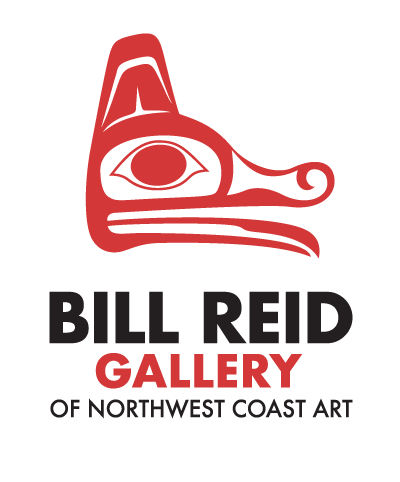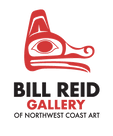NDN Giver
On view from September 27, 2025 – February 22, 2026
This exhibition marks the solo curatorial debut of BRG’s Assistant Curator, Amelia Rea (Haida).
NDN Giver explores the layered meanings within both everyday and extraordinary gifts that circulate through the potlatch. Blankets, coppers, canoes, prints, mugs, trade beads and devil’s club strung into necklaces all become carriers of law, memory, and relation to one another.
The title NDN Giver reclaims a phrase rooted in colonialism that mocked Indigenous generosity. In reality, the practice of giving upheld in the potlatch reflects the complexity of responsibilities in Indigenous governance and exchange. To give is to strengthen ties, and to receive is to take on the responsibility of carrying them forward.
This exhibition is not about objects alone, but about the stories they carry and the obligations they enact. Whether a humble mug or a crest-bearing treasure, they act as a living archive of law, love, accountability, and kinship.
"What’s in a mug? Or more specifically, what’s in a potlatch mug?
During lunch at my aunty and uncle’s house, I paused in front of a kitchen cabinet overflowing with mugs gifted at potlatches. It became clear that these mugs are more than vessels for coffee or tea. Each one is filled to the brim with family history, clan business, names bestowed, marriages celebrated, alliances formed, and truths spoken. To accept a gift at a potlatch is to accept responsibility to carry forward what transpired and to affirm agreement with the events that took place. And in truth, it is less a gift in the Western sense and more a form of payment, a recognition of the witness, and an obligation to remember, uphold, and retell the histories that were set into motion." – Amelia Rea
🔴 About Gudangee Xahl Kil Amelia Rea 🔴

Amelia is a member of the Tsiits Git’anee clan from Old Massett, Haida Gwaii, and a passionate Haida Nation-based scholar with deep roots in her culture. Raised immersed in the Haida language, singing, dancing, and repatriation, Amelia has spent her life learning and contributing to the preservation and transmission of Haida traditions. A lifelong member of the Haida Repatriation Committee, she follows the guidance of her mother, aunties, and elders, and has spent countless hours in museums, potlatches, language classes, and with cultural bearers across the community. This rich upbringing has instilled in Amelia a profound love for Haida culture and storytelling.
🔴 Featured Artists 🔴
Skil Jaadee White

Skil Jaadee White, from the Yahgu Janaas clan, was raised in a deeply cultural environment, learning Haida language, stories, and ceremonial practices from Elders throughout her childhood. She apprenticed under her father, Christian, to deepen her knowledge of formline design. These apprenticeships, supported by the YVR Art Foundation, allowed her to showcase her artwork at Vancouver International Airport. Skil Jaadee now creates original bleach-painted clothing through Studio Skil Jaadee, blending traditional design with modern expression. She is a lead dancer in the Tluu Xaada Naay dance group.
Photo by Georgie Lawson
K.C. Hall

K.C. Hall is a distinguished Heiltsuk artist from Bella Bella, British Columbia, known for his innovative and dynamic fusion of traditional Northwest Coast formline with contemporary graffiti and illustration. Born on May 26, 1986, and raised primarily in East Vancouver, Hall's artistic journey began with a passion for handwriting, lettering, and street art.
His formal introduction to his cultural artistic heritage came in 2012 when he studied Northwest Coast Jewellery Arts under the guidance of Nisga'a artist the late Robert Tait, at the Native Education College. This experience ignited his passion for formline design, a traditional art form of his ancestors, which he seamlessly blends with his pre-existing urban art style. This unique synthesis creates a visual language that is both deeply rooted in tradition and strikingly modern. Hall is the grandson of hereditary Chief Irene (Wakas) Brown and a descendant of the noted Heiltsuk artist Chief Robert Bell, further grounding his work in a rich ancestral legacy.
Photo courtesy of the artist
Glathba Charlie Brown

Glathba Charlie Brown is a Heiltsuk artist whose creative journey has been deeply connected to culture and ceremony since the age of three. Growing up immersed in the rich traditions of his people, Glathba’s earliest teachings came through family, community, and the cultural practices that have shaped his identity.
He began formal studies in art through archaeology, working alongside his uncle, Elroy White, whose guidance opened pathways to understanding ancestral designs, history, and the role of art in preserving Heiltsuk stories. This foundation has been strengthened through the generosity of master artists who have shared their knowledge of design and carving, allowing Glathba to carry these teachings forward with respect and gratitude.
At the heart of Glathba’s practice is a commitment to learning so that he can help tell his family’s stories visually and bring them to life in ceremony. His work reflects both tradition and personal growth, rooted in the responsibility of cultural continuity and the belief that art is a vessel for memory, identity, and healing.
Photo courtesy of the artist
Exhibition Supporters

Visit Us
We are located at 639 Hornby Street (between Georgia Street and Dunsmuir Street) in Downtown Vancouver. We are a little hard to find as our entrance is in a courtyard. Look for the sandwich board on Hornby Street and climb the short stairway.
A wheelchair-accessible path is also located between Christ Church Cathedral and Cathedral Place on Georgia Street. This takes you through the courtyard and to the Gallery entrance. Plan your visit.

